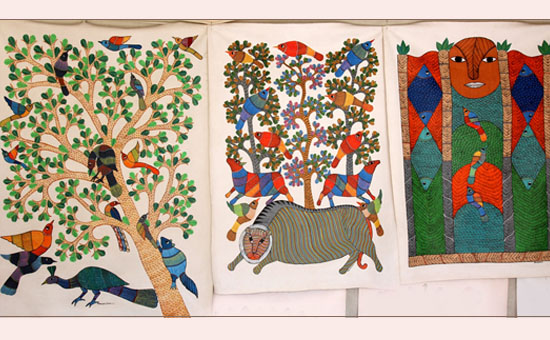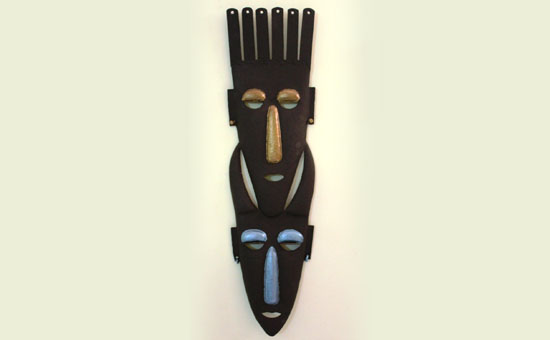On November 1 2000 Chhattisgarh was
carved out of the Indian state of Madhya Pradesh with
Raipur as its capital. The state is known for its mineral wealth, power generating capacity and contributes substantially to India’s steel production. High forest cover, tribal population and rich cultural heritage are also what it is known for.
When part of Madhya Pradesh Bastar was
one district. It had an area of 39,171 sq. km i.e. bigger than the state of
Kerala and countries like Belgium etc. Today it is split into smaller and more
manageable districts. App 70% of the population is tribal. The culture of
Bastar is influenced by Andhra Pradesh, Maharashtra, Orissa and Chhattisgarh
itself.
The heart of Chhattisgarh is Bastar. Discovered
in the 14th century Bastar is famous for its tribal history and culture.
Jagdalpur is the administrative headquarters of Bastar which was also its
capital at some point.
The region has many places of tourist interest namely Chitrakoot and Tirathgarh Waterfalls, Tamra Ghoomar, Kutumsar Caves, Danteswari Mandir, Haat Markets, Kanker Palace and temples, Barsur temples and the Kangar Valley National Park. Chitrakoot Waterfalls are called the ‘Niagara of India’. Bhoramdeo Mandir in the northern part of the state (about two hour’s drive from Raipur) is known as the Khajuraho of Chattisgarh.
The ancient Bastar Palace was built by the
Kaktiya dynasty and the Anthropological Museum, that conserved the idols of
Nagwanshi rulers, showcase the rich art and sculpture of earlier times.
Bastar is unique and diverse. It is home
to several tribal artisans who are proficient in creating the most intriguing
and exciting artwork from wood, terracotta and bell metal etc.
Bastar Dussehra is a 75 day
festival ie celebrated with great vigor and enthusiasm. Historians believe that
Kakitya ruler Purushaottam Deo visited Jagannath Temple Puri in the 15th century. During his return he came as ‘Rath-pathi’ with a divine permission to mount on a chariot.
The festival is celebrated not as a
victory of good over evil but as a congregation of native goddess of tribals,
Devi Mavli and her sisters. Dussehra here celebrates
the divine bliss of Goddess Danteswari - the revered deity of all tribes of
Chhattisgarh. Note that Kullu Dussehra in Himachal Pradesh is also
about the Mother Goddess with villagers congregating in Kullu.
The festival is celebrated by all major tribes of Bastar. Travel blogger Neelima wrote, “These include Kachan Gadi, Consecration of the couch of Devi Kachan who visits upon a young girl as she swings on a couch of thorns; Jogi Bithai, Installation of the yogi, a youth who sits on vigil for 9 days and nights to ensure festival success; The chariot procession etc. Bastar Dussehra concludes with the Muria Durbar, an assembly of headmen and public representatives. The deities are then accorded a farewell to return to their native seats in the hamlets of the district.”
The major tribes of Bastar
are the Gonds, Dhorla, Bisonhorn Maria, Muria, Halba, Dhurva, Gadba and Munda. The
Gonds play an important role in the tribal culture of Bastar and are well known
for their paintings as you see below.
 Gond Painting
Gond Painting
‘The tribes of Bastar region are known for their unique and distinctive tribal culture and heritage. Each tribal group has their own distinct culture and enjoy their own unique traditional living styles. Each tribe has developed its own dialect and differs from each other in their costume, eating habits, customs & tradition. They even worships different forms of god and goddess.’
‘The tribals of Bastar were amongst the earliest to work with metal and have expertise in making beautiful figurines of tribal gods, votive animals, oil lamps, carts and animals.’
Do visit the weekly Haat Market and witness cockfights. Excitement amongst watchers is
akin to a limited overs cricket match.
During a visit to Jagdalpur Museum got
to know about a unique system called GHOTUL. It is an institution where
unmarried boys and girls spend their nights. This regulates prenuptial
interest of the tribal youths as a training center to make them disciplined and
good members of society. Ghotul represents a genuine center for developing the
human spirit and some of the psychological and social problems at a certain
stage. Ghotul is found among Muria tribe of Bastar. Since some foreigners
misunderstood the concept, clicked pictures and sensationalized this system the
administration has stopped outsiders into villages where ghotul is practiced.
Bastar Art and Craft
Bastar has an antique style of wood art
and craft which comes in different sizes and shapes. The crafts are made up of
bell metal products, wooden carvings, bamboo decorative, terracotta items etc. Simple
items like wood, terracotta clay, bell metal and bamboo sticks are used. The
different art forms are -
1. Terracotta Art
The people of Bastar are skilled in
making handicrafts from terracotta. Terracotta is earthenware ceramic which
is reddish - brown in color. The clay of Bastar has tremendous plasticity and strength;
hence good for making big show pieces, masks, animal figures and sculptures.
Main centers of tribal terracotta are
Kumharpara, Nagarnar, Kondagaon, Narainpur and Kanker. Muria tribe living in
this area is involved mainly in pottery and agriculture. They make inexpensive
and durable terracotta craft items, handis and pots.
To buy terracotta items visit Saathi
Samaj Sewi Sanstha on the Kondagaon Narainpur road. It is an NGO that has been
working with tribal craft persons for over 20 years.
2. Bamboo Craft
Bamboo craft includes table lights, wall
hanging, table mats, and baskets, fishing traps and hunting tools. Near
Kondagaon visit Jagatram who makes lampshades from lauki (bottle gourd).
3. Bell Metal Handicrafts
Bell metal (Dhokra) handicraft is created
with help of the wax system. Decorative items such as nandi, horse, elephant,
Ganesha idols, candle holders and lamp shades are appreciated for their distinctive
designs, styles, patterns and uniqueness.
Close to highway and Jagatram village is
Kidaichepra, post Palari in Kondagaon district. Here number of villagers work
on Wrought Iron products. A state award winner and Master Craftman is Tiju Ram
Vishwakarma.
 Loved this - home of Tiju Ram
Loved this - home of Tiju Ram
4. Cast Metal images
Do visit the workshop of the highly
decorated Jaidev Baghel who has earned many awards for work in cast metal
images. He lives in Bhelwapadar Para. Home is 5 minute drive from Kondagaon
highway.
The process of making is - take black mud from fields, mix rice ka bhusa
with it to make a design. Dry properly for app 3-4 days. Take mud from river,
apply on piece then dry again. Mix it to give shape. Polish it with powder
generated in earlier step then dry. Use juice of Bin or Servi tree (available
locally) to paint it green and then dry. Next buy honey wax locally, burn it, melt
it, and filter with cloth, solution than solidifies. That solid is then use to
make Wire or Tar. This tar is used to make design. Take mud from banks of river
to refine it. Mix mud with charcoal powder, then apply mixture on image. Then
dry in sun. There are termite hills in the jungle. Get that, sprinkle water on
mud to make a dough which apply on image or Shilpi.
Then dry, apply 1-2 layers again on shilpi. Then treat in Bhatti or Oven where
wax melts. Also keep metal in Bhatti for it to melt and become a liquid. After
that metal poured on mould. When it gets cold remove the mud from the Shilpi
and keep it for drying before it is sent to the oven. When these two are joined
the final product emerges. In case of any errors do write back.
The craft of casting metal (ghadawakam) by the lost wax process is
called cire perdue in the West. It is practiced in India from the prehistoric
age.
5. Wood Craft
Tribals make god figures, wall
decorative items and wooden masks. Each of them is unique and reflects
workmanship of high quality. Being rich in forest cover makes sourcing of wood
easy. Different types of furniture are made here.
Chhattisgarh is also famous for its
lacquered and painted wooden craft items such as traditional boxes, toys,
flower vase, bedposts, candle holder, cots etc.
The artisans are skilled in making stunning
home decor items such as doors and wooden ceiling with the help of various
kinds of woods such as teak, shisham, sal, kikar, and dhundi. They also makes
window frames, mask, furniture, sculptures and decorative wall-hangings.
Keeping the Art Alive
A number of NGO’s and the State government are working to keep Bastar’s rich craft tradition alive. If we, as consumers buy and promote Bastar craft, artisans shall make money and the tradition shall continue.
The Chhattisgarh government emporium Shabri sells products made by local craftsmen.
Bastar is rich in culture, craft and has
many places of tourist interest. It is a must visit.
Editor – I visited Bastar in 2013 and met various artisans. Their contacts- Bamboo Jagatram 91 9755139614, 96178 32681. Tribal sculpture Jaidevji 91 94255 95341. Metalcraft Sonadhar 91 94061 05043, 77862 42882. Sculpture Suresh Waghmare 91 94242 76484. NGO Saathi Shri Harilalji B 91 94252 44027. All pictures by Sanjeev Nayyar.
Also read
1 Bastar Craft pictures
2 Chitrakoot Waterfalls
3 Kutumsar Caves
4 To know about Bastar Dussehra
5 Kullu Dussehra